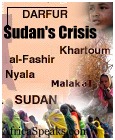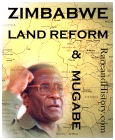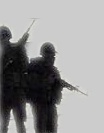 |






 AfricaSpeaks Weblog AfricaSpeaks Weblog
 Rootswomen Weblog Rootswomen Weblog
 Rootsie's Weblog Rootsie's Weblog
|
Desert Storms: A Battlefield from Hell
Posted: Wednesday, March 26, 2003
By BRUCE JACKSON
Winds in the Iraqi desert sandstorm have been blowing fifty miles and hour, bending date palms so their branches scrape the ground, reducing visibility to a few meters, rendering many weapons inoperable until the sand can be unpacked from barrels, chambers and sighting mechanisms. "It was biblical," a U.S. army colonel from Texas told a reporter. Were it not for digital cameras we'd have hardly any images at all because sand like this destroys film cameras. Rain fell yesterday, but it was mud falling from the sky, making everything worse rather than better. The temperature in the desert approached 100 degrees. If there is a battlefield from hell that is it.
And an ancient one. The invasion force in the Coalition of the Killing is driving its tanks across the motherland of Western culture. This is the Tigris-Euphrates Valley you learned about in high school: the Cradle of Civilization.
It is the location of Sumer, home of the hero Gilgamesh who in the 23rd century before Christ (or so) went to the cedar forest with his companion Enkidu and killed the giant Humbaba, and who then, after the miserable death of Enkidu, traveled to the island of Ut-Napishtim,the Faraway, who told him the story of the Great Flood and convinced him of the irreversibility of death. Gilgamesh came home, gave up his dream of immortality and conquest, and instead built a great wall around his city and told the story of what he'd learned.
It is also the site of ancient Babylon, seat of the empire of the 18th century ruler Hammurabi, whose great code foreshadowed the code of Moses the Lawgiver half a millennium later. Hammurabi's Code is nowadays trivialized to "an eye for an eye, a tooth for a tooth." It is, in modern parlance, a code of swift and severe and uncompromising revenge. It is, in fact, none of those things. The Code of Hammurabi is a code that limits violence rather than licences it. What the rest of the prose around eye for eye and tooth for tooth says is, That's it, that's as far as you go, revenge for an eye or tooth shall not be slaughter. It's a code about perspective, not blood.
There is another text that was central to Hammurabi's world, less known but no less important. It is usually referred to as the "Enuma elish," which is simply the first two words: "When on high."
The Enuma Elish, it seems, was recited every year at the Babylonian New Year's festival. It is one of the world's great creation myths. It is also a story of how the gods gave power to mankind. The purpose of the recitation, if the archaeologists are to be believed, was to remind mankind of its place in the order of the universe.
The central battle in Enuma Elish is between the great mother Tiamat and the young god Marduk. Tiamat's children have assigned Marduk the task of carrying out the war against Tiamat. He accepts the assignment but demands in exchange the power to remake the world when it is over. Tiamat's children, gods all, drunk, agree.
Tiamat and Marduk meet on a field of battle, each with huge and fearsome armies and weapons. But the armies never engage because one of Marduk's weapons is Imhullu, the wind, and he causes it to rage into the face of Tiamat. She is immobilized, her body swells, Marduk kills her with a spear thrust to the belly and rips her open and, in one of the most bizarre parodies of parturition in mythology, creates the universe as we know it from her destroyed body. Afterwards, the gods celebrate his victory and they assign him fifty names, in effect giving him the power previously held fifty separate cities and kingdoms and coalitions. Marduk becomes supreme ruler, master of the universe.
Humans are created to serve the gods and Marduk appoints one to be master of all, the ruler of the Babylonian empire. But every year in the New Year's festival that emperor would be stripped naked and slapped in the face by the priests until he wept, to remind him that the power he had was not his but was only his to administer, and that Marduk, who controlled Imhullu, the wind, was and would remain sole master of the universe. Marduk gave power to the priests, the priests gave power to the ruler, and only Marduk was eternal.
More or less. The remnants of Marduk and the emperors who submitted to humiliation in order for the priests to certify them as administrators of his earthly power are now pieces of stone tourists can look at in the museums of Iraq, Berlin, Paris, London and Rome. Time and the driven sand turned their palaces and empires to dust.
Sandstorms, windstorms—these are nothing new to the deserts of Iraq, and neither are death and destruction and raging empire and the rage for power. Empires come and go, conquerors come and are in turn themselves conquered, they bring death and they in turn die or are killed. The myth lives longer than they and the sand lives longer than either.
Bruce Jackson is SUNY Distinguished Professor and Samuel P. Capen Professor of American Culture at University of Buffalo. He edits Buffalo Report.
 Printer friendly version Printer friendly version
 Send page by E-Mail Send page by E-Mail
|








